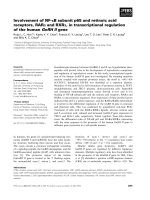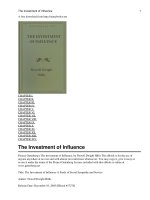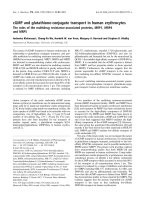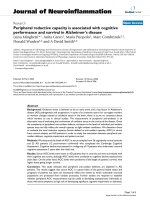Study of the associated proteins of STAT3 and characterization of their functions roles of GRIM 19 and PIN1 in the regulation of STAT3 activity
Bạn đang xem bản rút gọn của tài liệu. Xem và tải ngay bản đầy đủ của tài liệu tại đây (3.26 MB, 181 trang )
STUDY OF THE ASSOCIATED PROTEINS OF STAT3
AND CHARACTERIZATION OF THEIR FUNCTIONS:
ROLES OF GRIM-19 AND PIN1 IN THE REGULATION
OF STAT3 ACTIVITY
LUFEI CHENGCHEN
NATIONAL UNIVERSITY OF SINGAPORE
2006
STUDY OF THE ASSOCIATED PROTEINS OF STAT3
AND CHARACTERIZATION OF THEIR FUNCTIONS:
ROLES OF GRIM-19 AND PIN1 IN THE REGULATION
OF STAT3 ACTIVITY
LUFEI CHENGCHEN
B. Sc. (Hons), NUS
A THESIS SUBMITTED
FOR THE DEGREE OF DOCTOR OF PHILOSOPHY
INSTITUTE OF MOLECULAR AND CELL BIOLOGY
NATIONAL UNIVERSITY OF SINGAPORE
2006
i
Acknowledgement
First and foremost, my heartfelt gratitude goes to my supervisor, Associate
Professor Cao Xinmin, for her support, guidance, encouragement and patience
throughout my whole candidature.
I am also grateful to the past and present members in my supervisory committee,
Prof. Alan Porter, Assoc. Prof. Uttam Surana, Prof. Catherine Pallen and Asst. Prof.
Robert Z. Qi, for all the constructive suggestions and invaluable advices.
I would like to thank all the past and present members in the Stat3 laboratory of
IMCB, for the helpful discussion, sharing of reagents, and friendships. Special thanks
go to Dr. Huang Gouchang, for providing the high-quality GRIM-19 antibodies, Ms
Ma Jing, for providing some beautiful immunofluorescence pictures, Drs. Zhang Tong,
Novotny-Diermayr V., and Miss Ong Chin Thing for their helps in several reporter
assays in the GRIM19 project, and Mr. John Koh for his assistance in the Pin1 project.
I would also like express my appreciation to Dr. Uchida T. for providing the Pin1
deficient cells.
Finally, I dedicate this thesis to my parents, for their unconditioned love,
understanding and encouragement all these years.
ii
Table of Contents
Acknowledgement i
Table of Contents ii
List of Figures viii
List of Tables x
Abbreviations xi
Summary xiii
Chapter 1: Introduction 1
1.1 Signal transduction in mammalian cells 2
1.2 STAT family proteins 3
1.2.1 Isolation of STAT genes 3
1.2.2 Functional domains of STATs 5
1.2.2.1 N-terminal domain 6
1.2.2.2 Coiled-coil domain 10
1.2.2.3 DNA-binding domain 11
1.2.2.4 Linker domain 12
1.2.2.5 SH2 domain 13
1.2.2.6 STAT tyrosine phosphorylation 13
1.2.2.7 Transactivation domain 14
1.3 STAT signaling pathway 15
iii
1.3.1 JAK-STAT pathway in cytokine signaling 16
1.3.2 STAT activation by receptor tyrosine kinases and other kinases 17
1.4 STAT Serine phosphorylation 21
1.4.1 Kinases involved in STAT serine phosphorylation 21
1.4.2 Serine phosphorylation and STAT activity 22
1.5 Negative regulation of STAT signaling 23
1.5.1 Suppressors of cytokine signaling (SOCS) 23
1.5.2 Protein inhibitors of activated STATs (PIAS) 24
1.5.3 STAT ubiquitination and degradation 24
1.6 STAT deficient mice 25
1.7 STATs in oncogenesis 27
1.7.1 STAT3 in oncogenic signaling and tumor evasion 30
1.8 Gene associated with Retinoid-IFN-induced Mortality (GRIM-19) 32
1.8.1 Isolation of GRIM-19 32
1.8.2 Role of GRIM-19 in mitochondria 33
1.8.3 GRIM-19 interacting proteins 34
1.9 Peptidyl-prolyl isomerase Pin1 35
1.9.1 Isolation and activity characterization of Pin1 35
1.10 Biological functions of Pin1 38
1.10.1 Pin1 in cell-cycle regulation and apoptosis 38
1.10.1.1 Pin1 and cdc25 in cell cycle progression 38
1.10.1.2 Pin1 and p53, p73 tumor suppressor 39
iv
1.10.2 Pin1 in Alzheimer’s disease 40
1.10.3 Pin1, cyclin D1 and breast cancer 41
1.10.3.1 Pin1 and cyclin D1 upregulation 41
1.10.3.2 Pin1 in Neu/Ras induced mammary epithelial cell
transformation 42
1.10.4 Pin1 and PP2A-mediated dephosphorylation 43
1.11 Research aims 44
Chapter 2: Materials and Methods 46
2.1 Cytokines, growth factors, chemicals and reagents 47
2.2 Antibodies 48
2.3 Cell culture 48
2.4 Yeast two-hybrid screening 49
2.5 Molecular cloning 50
2.5.1 Preparing E. coli competent cells 50
2.5.2 Construction of expression plasmids 51
2.5.3 Techniques for expression plasmid construction 52
2.5.3.1 Restriction digestion of DNA 52
2.5.3.2 Gel extraction of DNA fragments 53
2.5.3.3 DNA ligation 53
2.5.4 Transformation of plasmids 54
2.5.5 DNA preparation 55
v
2.5.6 Agarose gel electrophoresis 56
2.6 Polymerase chain reaction (PCR) 56
2.7 Site-directed mutagenesis 57
2.8 Transfection in mammalian cells 58
2.8.1 DNA plasmids transfection 58
2.8.2 Transfection of siRNA oligonucleotides 59
2.9 Cell harvesting, immunoprecipitation and GST Pull-down assay 59
2.10 SDS-PAGE and Western analysis 60
2.11 Bacterial GST fusion protein production 61
2.12 Nuclear extraction, cell fractionation 62
2.13 Chloramphenicol acetyl transferase (CAT) assay 63
2.14 Luciferase assay 64
2.15 Electrophoretic Mobility Shift Assay (EMSA) 65
2.15.1 Probe labeling 65
2.15.2 EMSA 66
2.16 Immunofluorescence 66
2.17 Cell growth assay 67
Chapter 3: GRIM-19 suppresses Stat3 activity via functional interaction 68
3.1 Identification of GRIM-19 as a Stat3-interacting protein by yeast two-hybrid
system 69
3.2 Association of Stat3 and GRIM-19 in vivo and in vitro 69
vi
3.3 Physiological association of endogenous Stat3 and GRIM-19 in various
cell types 70
3.4 GRIM-19 does not associate with Stat1 and Stat5a 77
3.5 Mapping the regions that mediate the interaction between Stat3 and
GRIM-19 77
3.6 Cellular localization of GRIM-19 82
3.7 Co-localization of GRIM-19 with Stat3 and its effect on Stat3 nuclear
Translocation 86
3.8 GRIM-19 represses Stat3-dependent transcription 91
3.9 GRIM-19 inhibits cell growth 92
3.10 Discussion 97
Chapter 4: Pin1 positively regulates Stat3 activity via serine phosphorylation site
104
4.1 Association of Stat3 and Pin1 in vivo and in vitro 105
4.2 Pin1 promotes Stat3 transcriptional activity 106
4.3 Pin1 upregulates Stat3 transcriptional activity via the Ser727 residue
of Stat3 110
4.4 Stat3 DNA binding ability is impaired in the Pin1 knockout MEFs 113
4.5 Pin1 increases Stat3 and p300 binding 118
4.6 Effects of Pin1 on Stat3 ubiquitination 121
4.7 Role of Ser727 in Stat3 ubiquitination and protein degradation 122
vii
4.8 Discussion 128
References 136
viii
List of Figures
Figure 1.1 Organization of STAT Functional domains 5
Figure 1.2 Ribbon diagram of the Stat3β homodimer–DNA complex 8
Figure 1.3 The STAT4 N-domain dimer suggested by crystal packing 9
Figure 1.4 JAK-STAT signaling pathway 20
Figure 1.5 Overall fold of human Pin1 37
Figure 3.1 Interaction of Stat3 and GRIM-19 71
Figure 3.2 Association of endogenous Stat3 and GRIM-19 75
Figure 3.3 Lack of interaction between GRIM-19 and other STAT proteins 78
Figure 3.4 Mapping of the interacting regions of Stat3 and GRIM-19 79
Figure 3.5 Cellular localization of GRIM-19 in MCF-7 cells 84
Figure 3.6 Co-localization of Stat3 with GRIM-19 88
Figure 3.7 Effect of GRIM-19 on the transcriptional activity of Stat3 and
target gene expression 93
Figure 3.8 Inhibition of Stat3-mediated cell proliferation by GRIM-19 96
Figure 4.1 Association of Stat3 and Pin1
107
Figure 4.2 Pin1 promotes Stat3 transcriptional activity and target gene
Expression 111
Figure 4.3 Pin1 does not promote the transcriptional activity of Stat3
S727A point mutant 114
Figure 4.4 Pin1 effects on the activation of Stat3 116
Figure 4.5 Pin1 increases Stat3 and p300 interaction 119
ix
Figure 4.6 Effect of Pin1 on Stat3 ubiquitination and protein degradation 124
x
List of Tables
Tabl e 1.1 JAKs-STATs activation 18
Tabl e 1.2 STAT deficient mice 26
Tabl e 1.3 Tissue-specific role of Stat3 28
Tabl e 1.4 Activation of STATs in human primary tumors and tumor cell lines 29
Tabl e 1.5 STATs activation by oncogenes 31
xi
Abbreviations
Ala alanine
CAT chloramphenicol acetyl transferase
CBP CREB binding protein
DMEM Dulbecco’s modified Eagle’s medium
DTT dithiothreitol
ECL enhanced chemiluminescence
EDTA ethylenediamine tetra-acetic acid
EGF epidermal growth factor
FBS fetal bovine serum
GAS IFN-γ activated site
GST glutathione S-transferase
IFN interferon
IL-6 interleukin-6
ISGF-3 interferon-stimulated gene factor 3
ISRE interferon-stimulated response element
JAK Janus kinase
LB Luria Bertani
OSM oncostatin M
PAGE polyacrylamide gel electrophoresis
PBS phosphate buffered saline
xii
PIAS protein inhibitor of activated STAT
PPIase peptidyl-prolyl isomerase
PMSF phenylmethylsulfonyl fluoride
PVDF polyvinylidene difluoride
RIPA radioimmune precipitation assay
SDS sodium dodecyl sulphate
Ser serine
SH2 Src homology 2
SH3 Src homology 3
SIE sis-inducible element
STAT signal transducers and activators of transcription
SOCS suppressor of cytokine signaling
TAD transactivation domain
Thr threonine
Tyr tyrosine
xiii
Summary
Cytokines exert multiple biological responses through interaction with their specific
receptors that results in the activation of JAK−STAT pathways. STATs (signal
transducers and activators of transcription) are a family of latent cytoplasmic
transcription factors which are activated by recruitment to the cytokine receptors and
subsequent phosphorylation by the receptor-associated Janus kinases (JAKs). Stat
proteins form homo- or heterodimers by reciprocal interaction between SH2 domains
and phosphorylated tyrosine residues, translocate into the nucleus, bind to DNA and
regulate their target gene expression. Stat3 originally was cloned as an acute-phase
response factor activated by interleukin-6, and also by homology to Stat1. Growth
factors can also stimulate Stat3 activity. Stat3 plays crucial roles in early embryonic
development, as well as in other biological responses including cell growth and
anti-apoptosis. Stat3 is constitutively activated in oncogenic tyrosine kinase v-Src- or
v-abl-transformed cells, and various primary tumors and cell lines. Stat3 itself acts as
an oncogene in NIH-3T3 cells. Therefore, the control of both the activation and
inactivation of Stat3 is equally important to maintain normal cell growth.
In the first part of this thesis, I described the identification of GRIM-19 as a novel
regulator of Stat3 that suppresses it activity via functional interaction. I examined Stat3
potential regulators by yeast two-hybrid screening. GRIM-19, a gene product related to
interferon-beta- and retinoic acid-induced cancer cell death, was identified and
demonstrated to interact with Stat3 in various cell types. The interaction is specific for
xiv
Stat3, but not for Stat1 and Stat5a. The interaction regions in both proteins were
mapped, and the cellular localization of the interaction was examined. GRIM-19 itself
co-localizes with mitochondrial markers, and forms aggregates at the perinulear region
with co-expressed Stat3, which inhibits Stat3 nuclear translocation stimulated by EGF.
GRIM-19 represses Stat3 transcriptional activity and its target gene expression, and
also suppresses cell growth in Src-transformed cells and a Stat3-expressing cell line.
In addition to the tyrosine phosphorylation, phosphorylation at Stat3 Ser727 residue
also plays an important role in the regulation of Stat3 transactivation. In the second
part of this thesis, I reported peptidyl-prolyl isomerase Pin1 as a key regulator that
positively regulates Stat3 activity via its serine phosphorylation site. Pin1 binds
specifically to the activated Stat3 upon cytokine/ growth factor stimulation via its
Ser727 site. Pin1 was demonstrated to promote Stat3 transcriptional activity and target
gene expression in various cell types, but not that of the Stat3 S727A mutant. Stat3
DNA binding ability is significantly compromised in Pin1 deficient cells, and
expression of Pin1 dramatically increases the cytokine-induced interaction between
Stat3 and p300 coactivator. In addition, Pin1 was also shown to protect activated Stat3
from ubiquitination.
In summary, my data suggest GRIM-19 and Pin1 as two novel associated proteins of
Stat3, which regulate its activity by distinct mechanisms.
Chapter 1: Introduction
1
Chapter 1
Introduction
Chapter 1: Introduction
2
Signal transduction in mammalian cells
Cells receive various extracellular stimuli from the environment and respond to these
signals by altering multiple cellular activities including cell growth, cell differentiation,
apoptosis or cell movement. Studies of signal transduction in mammalian cells mainly
focus on the process how the extracellular stimuli received at the cell surface are
transmitted into the cell and trigger the subsequent intracellular responses. One of the
typical processes in cell signaling involves the selective recognition of ligands, such as
growth factors and cytokines, by the extracellular domain of cell surface receptors that
are usually transmembrane proteins. The specific ligand binding to the receptors
triggers dimerization/ oligomerization of the receptors (probably involving other
membrane proteins), or in some other cases induces conformational change in the
receptor cytosolic domains, and in both cases leads to the subsequent activation of
receptors. The activated receptors in turn recruit a group of intracellular signaling
molecules to the receptors, which enables propagation of the incoming signal via
multiple pathways. Some terminal signal recipients can migrate into the nucleus where
they activate nuclear transcription factors to the target genes, while some others are
already latent cytoplasmic transcription factors themselves, which can bind to DNA
directly upon the nuclear translocation. Cellular responses to the outside stimuli are
eventually achieved by the expression of various target genes and subsequent alteration
of multiple cellular events.
Chapter 1: Introduction
3
1.1 STAT family proteins
Signal transducers and activators of transcription (STATs) are a family of latent
cytoplasmic transcription factors that play important roles in multiple cytokine
signaling. As indicated by their name, STATs are signaling proteins with dual functions,
transmitting signals from the cell surface through the cytoplasm and directly
participating in the gene regulation within the nucleus. To date all together seven
mammalian STAT family proteins have been identified, namely Stat1, Stat2, Stat3,
Stat4, Stat5a, Stat5b and Stat6.
1.21 Isolation of STAT genes
The STAT gene family was first identified through a genetic screening for the signaling
molecules required for the interferon (IFN)-induced transcription. Following the
isolation of a group of complementary DNA (cDNAs) corresponding to the
interferon-induced mRNA, a DNA response element, named as interferon-stimulated
response element (ISRE) was identified (Levy et al., 1988). Subsequently an ISRE
binding complex was purified and termed as interferon-stimulated gene factor-3
(ISGF3) (Kessler et al., 1990), followed by the identification of four constituent
components of the ISGF3 complex, three of which were highly related to each other
(p84, p91 and p113) (Fu et al., 1990). Further characterization of these ISGF3
components led to the cloning of both Stat1 and Stat2 genes (Fu et al., 1992; Schindler
et al., 1992). The components p91 and p84 actually were products of the same gene
through alternative splicing, known as Stat1α and Stat1β now, and the p113
Chapter 1: Introduction
4
component is now Stat2.
Stat3 and Stat4 were identified by a few research groups through low stringency
hybridization in the cDNA library using a probe from the most highly conserved SH2
domain of the Stat1 gene (Zhong et al., 1994a, Zhong et al., 1994b, Raz et al., 1994,
Yamatomo et al., 1994). Stat3 was also isolated independently as a DNA binding factor
to the IL-6 response element present in the promoter region of acute phase genes, and
named acute phase response factor (APRF) (Akira et al., 1994). There are also two
alternatively spliced transcripts of the Stat3 gene, Stat3α and Stat3β (Schaefer et al.,
1995). The difference resides at the carboxyl-terminal where Stat3β lacks the 55
C-terminal amino acid sequence of Stat3α, but has additional seven residues instead.
Stat5 was originally purified as a mammary gland factor from the prolactin-stimulated
mammary tissue, binding to the regulatory elements of the β-casein gene (Wakao et al.,
1994), and also as the DNA binding factor in IL3-stimulated myeloid cells (Azam et al.
1995). Two related clones of Stat5 were subsequently isolated and named Stat5a and
Stat5b, which are encoded by two separate genes (Copeland et al., 1995). Similarly,
Stat6 was discovered from IL-4-stimulated myeloid cells as an IL-4-induced DNA
binding factor (Hou et al., 1994).
STAT homologues have been identified in various species other than mammals, such
as chicken, Tetraodon fluviatilis (puffer fish), Danio rerio (zebrafish), Xenopus laevis,
Drosophila melanogaster and C. elegans. Both Stat1 and Stat3 homologues have been
isolated in zebrafish (Oates et al., 1999), in which the expression of zebrafish Stat3 is
tissue-specific during embryogenesis. The Drosophila STAT homologue Stat92E was
Chapter 1: Introduction
5
isolated independently by two groups (Hou et al., 1996; Yan et al., 1996). It plays an
important role in the early embryonic development of flies, and is downstream of
Hopscotch (Drosophila JAK), which indicates the presence of JAK-STAT signaling in
invertebrates. STAT homologues related to Stat5 have been identified in both Xenopus
(Pascal et al., 2001) and C. elegans (Liu et al., 1999). Even in the low eukaryote
Dictyostelium (slime mold), a STAT protein, which also functions through
phosphotyrosine-SH2 reciprocal dimerization, has been isolated (Kawata et al., 1997),
which suggests that STAT genes are evolutionarily conserved.
1.2.2 Functional domains of STATs
All the seven members of STAT proteins are 750 to 850 amino acids in length, having
molecular mass as from ~90 to ~115 kDa. They all share a similar organization of
several well-defined and structurally conserved functional domains as shown in Figure
1.1.
Figure 1.1 Organization of STAT Functional domains
In the year 1998, three-dimensional crystal structures of both DNA-bound Stat1 and
DNA Binding
Linker
SH2
TAD
N-domain
Coiled-coil
pY
Chapter 1: Introduction
6
Stat3β (short form of Stat3α lacking the C-terminal domain) dimers were resolved,
which share very high structural similarity to each other. As show in Figure 1.2, The
STAT homodimer grips the DNA like a pair of pliers, and the only contacts between
the monomers occurs between the SH2 domains (Becker et al., 1998; Chen et al.,
1998). The coiled-coil domain is a bundle of four antiparallel helices, two long ones
(α1 and α2) and two short ones (α3 and α4). The predominantly hydrophilic surface
of the coiled-coil structure has been suggested to mediate the interaction with other
proteins. The DNA-binding domain resembles an eight-stranded β-barrel, where
several loops between the β strands of this domain participate in DNA-binding.
Between the DNA binding and SH2 domain is the linker region, a small helical domain
formed by two helix-loop-helix modules. The STAT SH2 domain shares homology
with other SH2 modules with a central three-stranded β-pleated sheet flanked by two
helices, whereas the carboxyl-portion of STAT SH2 is more divergent from the
classical ones.
1.2.2.1 N-terminal domain
The very N-terminal domain (123 to 145 amino acids in length) of STAT proteins is a
stable domain sharing a high degree of sequence similarity within different STAT
members. This domain has been suggested to mediate the cooperative interaction,
namely the tetramerization of two STAT protein dimers bound to DNA, and such
cooperative binding leads to a prolonged half-life of the STAT protein-DNA complex
(Xu et al., 1996; Vinkemeier et al., 1996). The crystal structure of the Stat4 N-terminal
Chapter 1: Introduction
7
domain has been resolved, which consists of eight helices that are assembled into a
hook-like structure. It was suggested that the N-terminal domains may interact through
an extensive interface formed by polar interaction (Vinkemeier et al., 1998). Later an
alternative interface that is more extensive and involves hydrophobic interactions was
suggested (Figure 1.3), and point mutations of several residues at this interface
obviously affected the N-terminal dimer stability (Chen et al., 2003). Recently, the
crystal structure of unphosphorylated human Stat1 complexed with an IFNγ receptor α
chain-derived phosphopeptide has been resolved, which reveals two dimer interfaces,
one of which is between the N-terminal domains. It was suggested that Stat1 is
predominantly dimeric before activation, and the dimerization is mediated by the
N-domain interactions (Mao et al., 2005).
Methylation of Stat1 Arg31 residue by methyl-transferase PRMT1 was also described,
which increased Stat1 DNA binding and transcriptional activity by interfering with the
binding of activated Stat1 to its negative regulator PIAS1 (Mowen et al., 2001).
Interaction of the N-terminal domain with various other proteins has been reported,
including the interaction between the Stat1 N-domain with transcriptional coactivator
p300/CBP through the CREB-binding domain (Zhang et al., 1996), and STAT
N-domain binding to the intracellular regions of cytokine receptors (Li et al., 1997,
Murphy et al., 2000). A regulatory role of the N-terminal domain in STAT nuclear
translocation has also been uncovered by studies in which replacement of the Stat1
N-domain with the homologous domain of other STATs leads to impaired nuclear
translocation of the mosaic mutants (Strehlow and Schindler, 1998).
Chapter 1: Introduction
8
Chapter 1: Introduction
9
Figure 1.2. Ribbon diagram of the Stat3β homodimer–DNA complex.
The N-terminal 4-helix bundle is shown in blue, the β-barrel domain in red, the
connector domain in green, and the SH2 domain and phosphotyrosine-containing
region in yellow. Disordered regions between helices α1 and α2 and residues 689 to
701 have been modeled in grey. Views are shown a, along the DNA axis (the dyad of
the complex running vertically); b, from the side, with monomer 2 depicted in grey;
and c, from the top. Phosphotyrosines are indicated by a Y in c.
(This Figure is from Becker et al., 1998)
Figure 1.3. The STAT4 N-domain dimer suggested by crystal packing Close-up
views of the alternate dimer interface are presented, and the residues involved in dimer
formation are indicated.
(This figure is from Chen et al., 2003)








![Báo cáo khoa học: Accessory proteins functioning selectively and pleiotropically in the biosynthesis of [NiFe] hydrogenases in Thiocapsa roseopersicina docx](https://media.store123doc.com/images/document/14/rc/tv/medium_tvi1396203611.jpg)
